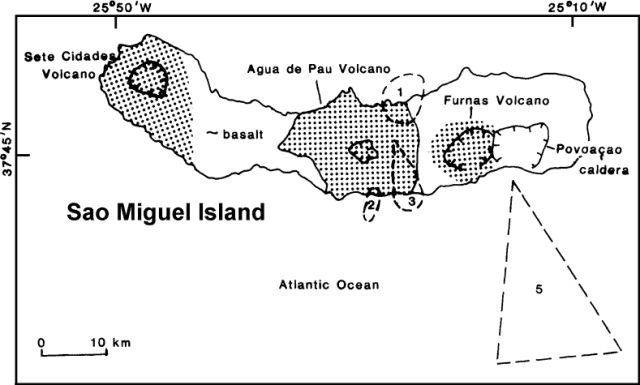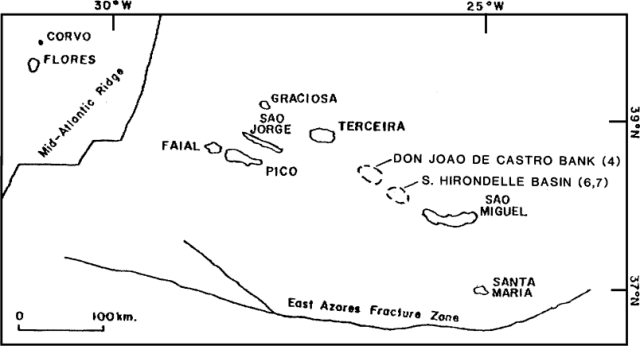Report on Additional Reports (Unknown) — March 1989
Scientific Event Alert Network Bulletin, vol. 14, no. 3 (March 1989)
Managing Editor: Lindsay McClelland.
Additional Reports (Unknown) Azores-Gibraltar Fracture Zone: Seismicity since May 1988 summarized
Please cite this report as:
Global Volcanism Program, 1989. Report on Additional Reports (Unknown) (McClelland, L., ed.). Scientific Event Alert Network Bulletin, 14:3. Smithsonian Institution. https://doi.org/10.5479/si.GVP.SEAN198903-600500
Additional Reports
Unknown
Lat Unknown, Unknown; summit elev. m
All times are local (unless otherwise noted)
The following is a summary of significant seismic activity in the E Azores (figure 1) since May 1988 [through January 1989]. "A swarm of microearthquakes, accompanied by weak harmonic tremor, occurred beneath the NE flank of Agua de Pau Volcano on Sao Miguel (epicentral zone 1 on figure 2) 23-24 May 1988. Seismometers recorded 383 earthquakes; the largest had intensities of MM IV-V in villages along the N coast. A similar but smaller swarm occurred in the same area in 1983 and was recorded by USGS seismographs. Numerous, small, normal faults (including some that show scissor-type movement) displace basaltic, tristanitic, and trachytic vent deposits and flows in this area. However, the area has had no eruptions for about 3,000 years and is the least active of the five volcanic zones on Sao Miguel that have erupted during Holocene time.
 |
Figure 2. Approximate epicenters for earthquakes on and near the island of Sao Miguel, May-October, 1988. Courtesy of R. Moore. |
"A small swarm of microearthquakes occurred 24-26 June on the S flank of Agua de Pau Volcano (zone 2). Sixty-four earthquakes were recorded; the largest had intensities of MM III-IV in nearby villages. No tremor accompanied this episode.
"A small swarm of microearthquakes occurred 6 July near the S coast of Sao Miguel (zone 3). Fifty-one earthquakes were recorded; the largest was felt and had an intensity of MM III-IV. No tremor accompanied this episode.
"A small swarm of earthquakes occurred within the volcano Don Joao de Castro Bank (zone 4) 3-5 October. Sixty-two earthquakes were recorded; no harmonic tremor was detected. A felt earthquake occurred in the same area 23 October; it had intensities of MM IV-V on Terceira and MM III-IV on the N coast of Sao Miguel.
"A swarm of tectonic earthquakes, many of which were felt, occurred beneath the ocean floor about 30 km S of the extinct Povoaçao Volcano (zone 5) 16-20 October 1988. Seismometers recorded 409 earthquakes during this period; the largest had an intensity of MM VI in towns on the S coast of Sao Miguel. Felt aftershocks occurred as recently as late February 1989. No harmonic tremor accompanied this activity. Epicenters were aligned along a N-NW trend; hypocenters generally ranged from 10 km to as shallow as 400 m. Furnas Volcano, which adjoins Povoaçao on its W side and most recently erupted in A.D. 1630, has numerous boiling drowned hot springs and derivative 'fumaroles' that emit only water vapor. Temperatures of the hot springs depend on elevation and range from 98.5° to 100°C. The associated 'fumaroles' are much cooler and are subject to further cooling during periods of heavy rain.
"The largest Azores earthquake of the last year, M 5.8, occurred within the S Hirondelle Basin (zone 6), SE of Don Joao de Castro Bank, on 21 November. The earthquake was widely felt in the E Azores and caused minor damage on the W part of Sao Miguel, where intensities were MM VI-VII. The quake was apparently tectonic in origin as no harmonic tremor occurred during its normal aftershock sequence. An earthquake of MM V (measured near the NW coast of Sao Miguel) occurred 21 January 1989 within the S Hirondelle Basin. The earthquake was probably an aftershock of the 21 November event. No tremor was recorded."
Geological Summary. Reports of floating pumice from an unknown source, hydroacoustic signals, or possible eruption plumes seen in satellite imagery.
Information Contacts: A. Rodrigues da Silva, Consorcio Geotermico de S. Miguel; R. Moore, USGS; National Institute of Meteorology and Geophysics, Portugal.


